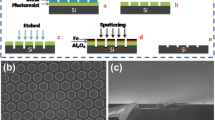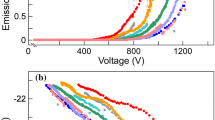Abstract.
Carbon nanotube arrays were prepared by chemical vapor deposition (CVD) of hydrocarbon gas on various substrates. The effect of substrates on the growth, morphology and structure of carbon nanotubes were investigated. Aligned carbon nanotubes with high density and purity were achieved by CVD on bulk silica substrate. On the film-like substrates, very long carbon nanotubes of length ∼2 mm were produced, which is an order of magnitude longer (1 mm vs. 100 μm) than that described in most previous reports. High-resolution transmission electron microscopy (HRTEM) investigation illustrates that these carbon nanotubes are well graphitized and very pure. The tubes are typically consist of several to tens of concentric shells of carbon sheets with spacing about 0.34 nm. Micro-Raman spectroscopy has been carried out to detect the microstructures of CNT. The observed ratio of the integrated intensity of D and G band was found different from that of carbon nanotubes produced by arc-discharge method and pyrolytic graphite (PG). The resonance properties and higher order Raman bands are also different from other forms of carbon. With the help of the results of SEM and HRTEM the origination of the broader band structure were discussed.
Similar content being viewed by others
Author information
Authors and Affiliations
Additional information
Received: 31 August 1998 / Received in final form: 5 November 1998
Rights and permissions
About this article
Cite this article
Xie, S., Li, W., Pan, Z. et al. Carbon nanotube arrays. Eur. Phys. J. D 9, 85–89 (1999). https://doi.org/10.1007/s100530050404
Issue Date:
DOI: https://doi.org/10.1007/s100530050404




